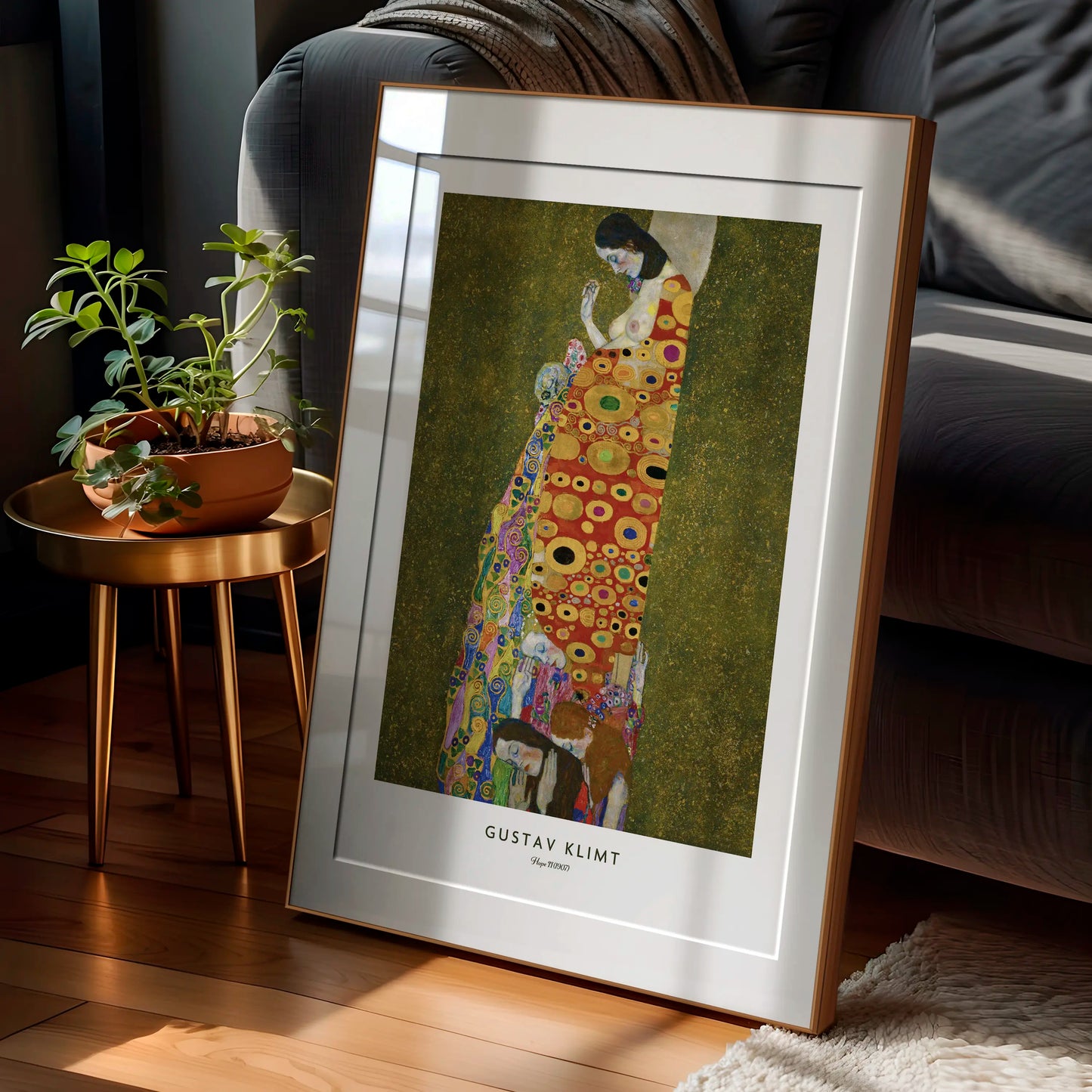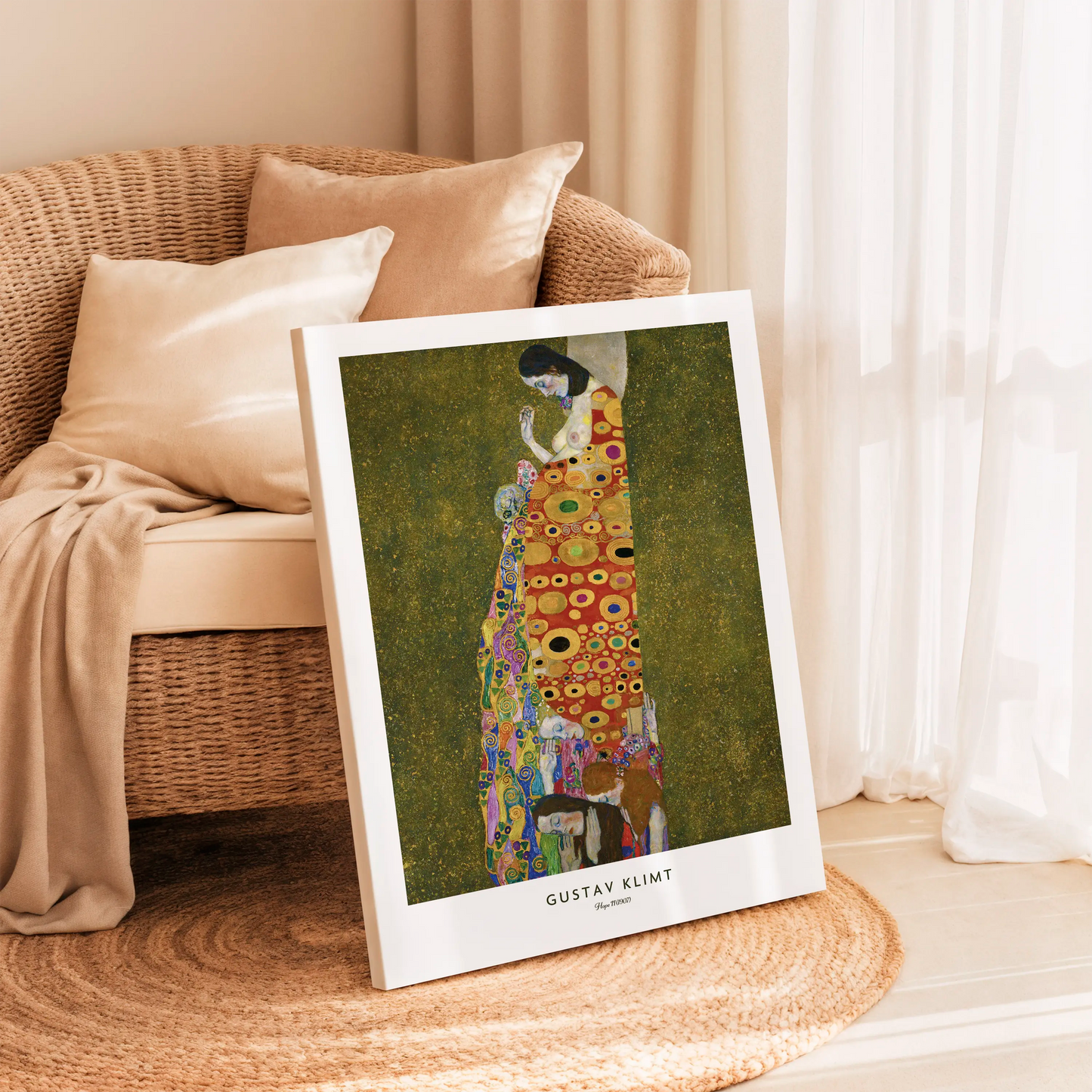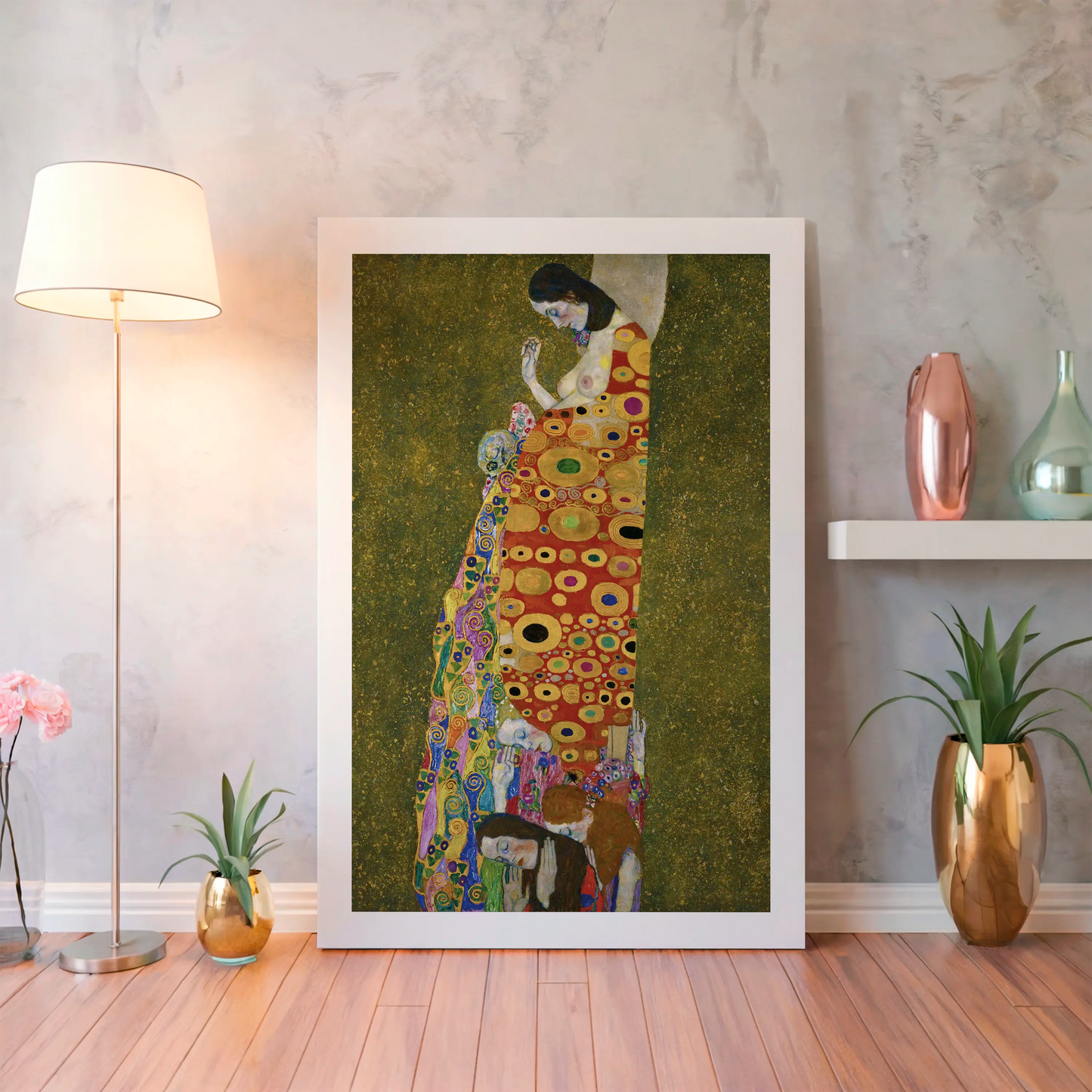Gustav Klimt - Hope II (1907) - Digital File N173
Gustav Klimt - Hope II (1907) - Digital File N173
Couldn't load pickup availability
Share
Paper Poster | Canvas Print | Digital File
1. Historical and Artistic Context
Gustav Klimt painted Hope II between 1907 and 1908, during his celebrated Golden Phase. This period marked his peak engagement with ornamental gold, mosaic-inspired decoration, and symbolic subject matter. Vienna at the turn of the century was a center of radical artistic and intellectual innovation, with the Vienna Secession movement, founded by Klimt in 1897, rejecting academic traditions and embracing modernist experimentation. Hope II builds on themes Klimt explored earlier in Hope I (1903), a work that scandalized viewers for its frank portrayal of a nude pregnant woman. In Hope II, Klimt refined his approach, retaining the subject’s emotional intensity while presenting her clothed in richly decorated robes. The painting reflects Vienna’s cultural fascination with life, death, and sexuality in the early 20th century, mirroring broader Symbolist currents across Europe.
2. Technical and Stylistic Analysis
The composition presents a monumental pregnant woman, viewed in profile, her head bowed and hands resting near her chest. She wears a long robe patterned with gold, circles, spirals, and rectangles, which contrast with the naturalistic modeling of her exposed flesh. At the base, three smaller women bow in prayer or mourning, while behind her belly a skull stares outward, an unsettling counterpoint to the life she carries. Klimt’s flattened ornamental surface, inspired by Byzantine mosaics, is juxtaposed with the volumetric rendering of the human body. The shimmering gold background, flecked with starlike particles, reinforces the sense of timelessness. The square format, unusual for Klimt, emphasizes the central figure’s monumental presence and creates a balance between sacred icon and modern painting.
3. Symbolism and Interpretation
Hope II is steeped in symbolism. The pregnant woman symbolizes hope, continuity, and renewal, yet the skull near her womb reminds viewers of mortality and the fragility of life. The three kneeling figures may represent midwives, mourners, or an allegorical chorus, echoing the solemnity of the moment. The geometric patterns on the robe, particularly the egg-like forms, reinforce themes of fertility and creation. The title itself carries a linguistic pun, since the German word Hoffnung can mean both “hope” and “expectancy,” directly linking motherhood with anticipation and faith in the future. This duality—birth and death, hope and dread—is central to the painting’s meaning, presenting existence as a perpetual balance between life’s promise and its inevitable end.
4. Technique and Materials
The painting was executed in oil with gold and platinum on canvas, measuring 110.5 by 110.5 centimeters. Klimt drew on his mastery of combining precious metal leaf with traditional pigment, a skill influenced by his father’s background as a gold engraver. The background and robe are enriched with metallic applications that catch light and create a luminous, almost cosmic effect. Overlapping layers of metallic leaf, paint, and fine detailing give the surface a tactile richness. Klimt’s method was meticulous, involving the careful application of gold leaf over prepared surfaces, blending traditional craftsmanship with avant-garde symbolism. The shimmering flatness contrasts with the dimensional rendering of the woman’s skin, intensifying the dialogue between surface ornament and human vulnerability.
5. Cultural Impact
At a time when depictions of pregnancy were rare in art, Hope II challenged societal norms and taboos. Klimt’s frank engagement with themes of maternity and mortality resonated with Viennese intellectual circles shaped by Freud, Nietzsche, and other thinkers who explored primal instincts and existential tension. The painting has since become an icon of Symbolist art, valued for its fusion of beauty and unease. It influenced later Expressionist and modernist explorations of the human condition and continues to inspire contemporary discourse on femininity, sexuality, and the precariousness of life. Its bold representation of a pregnant figure remains groundbreaking even today.
6. Critical Reception and Scholarly Interpretations
When first shown at the Vienna Kunstschau in 1908, the painting provoked controversy but less outrage than its predecessor Hope I. Critics found the subject matter unsettling, though many admired its decorative splendor. For decades it was overshadowed by Klimt’s more famous works, such as The Kiss, but modern scholarship has reevaluated its significance. Today, art historians emphasize its dual allegory of hope and mortality, while feminist scholars highlight its progressive portrayal of a pregnant woman as central, dignified, and autonomous. Critics also note how the painting captures both psychological depth and formal brilliance, positioning it as a key example of Klimt’s Golden Phase.
7. Museum, Provenance and Exhibition History
Hope II entered the collection of the Museum of Modern Art (MoMA) in New York in 1978, acquired through the support of the Lauder family. Previously, the painting had passed through several private collections in Austria and Switzerland after being first exhibited at the Vienna Kunstschau in 1908. Its acquisition by MoMA secured its place as a cornerstone of the museum’s Symbolist holdings. Since then, it has featured in major exhibitions of Klimt’s work and broader shows on early modernism, reaffirming its reputation as one of Klimt’s masterpieces.
8. Interesting Facts
1. Klimt originally titled the painting Vision, not Hope II.
2. The German word Hoffnung means both “hope” and “expectancy,” reinforcing the theme of pregnancy.
3. The model is believed to be Herma, who also posed for Hope I.
4. The canvas is a perfect square, which is unusual in Klimt’s oeuvre.
5. Klimt used platinum in addition to gold, a rare material for painters at the time.
6. The skull directly symbolizes the dangers of childbirth in the early 20th century.
7. The egg-shaped motifs on the robe symbolize fertility and new life.
8. Hope II was exhibited in Vienna in 1908 at the inaugural Kunstschau.
9. The painting was privately owned for seventy years before entering MoMA’s collection.
10. It was created at the same time as The Kiss, sharing stylistic and symbolic parallels.
9. Conclusion
Hope II is a profound work that exemplifies Gustav Klimt’s Golden Phase, combining technical brilliance with existential depth. It balances beauty with unease, presenting a universal meditation on life’s fragility and promise. The pregnant figure radiates both serenity and vulnerability, while the skull reminds viewers of the ever-present shadow of death. Its daring subject, exquisite craftsmanship, and symbolic power ensure its place as one of Klimt’s most compelling achievements, a painting that continues to resonate with audiences more than a century after its creation.













